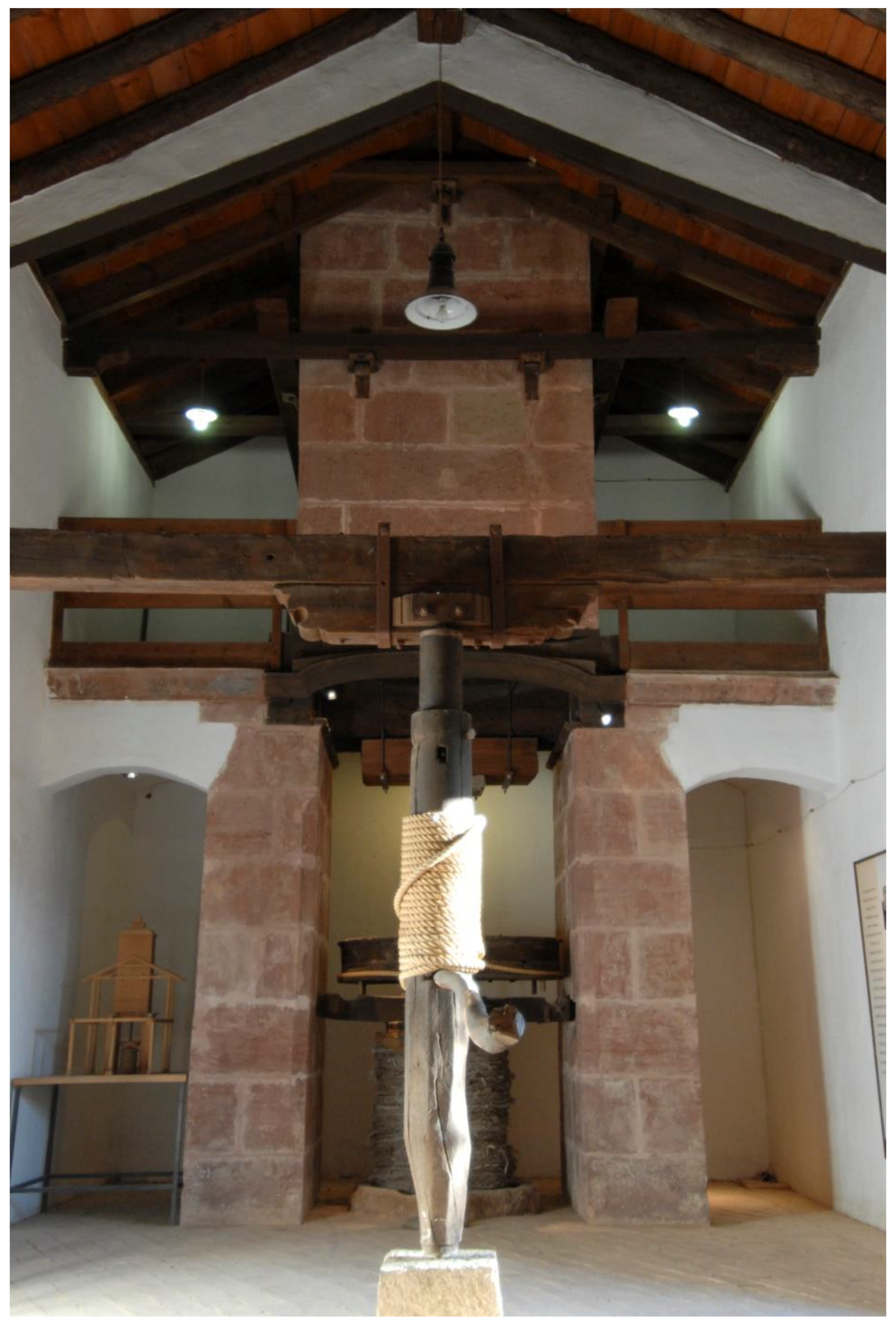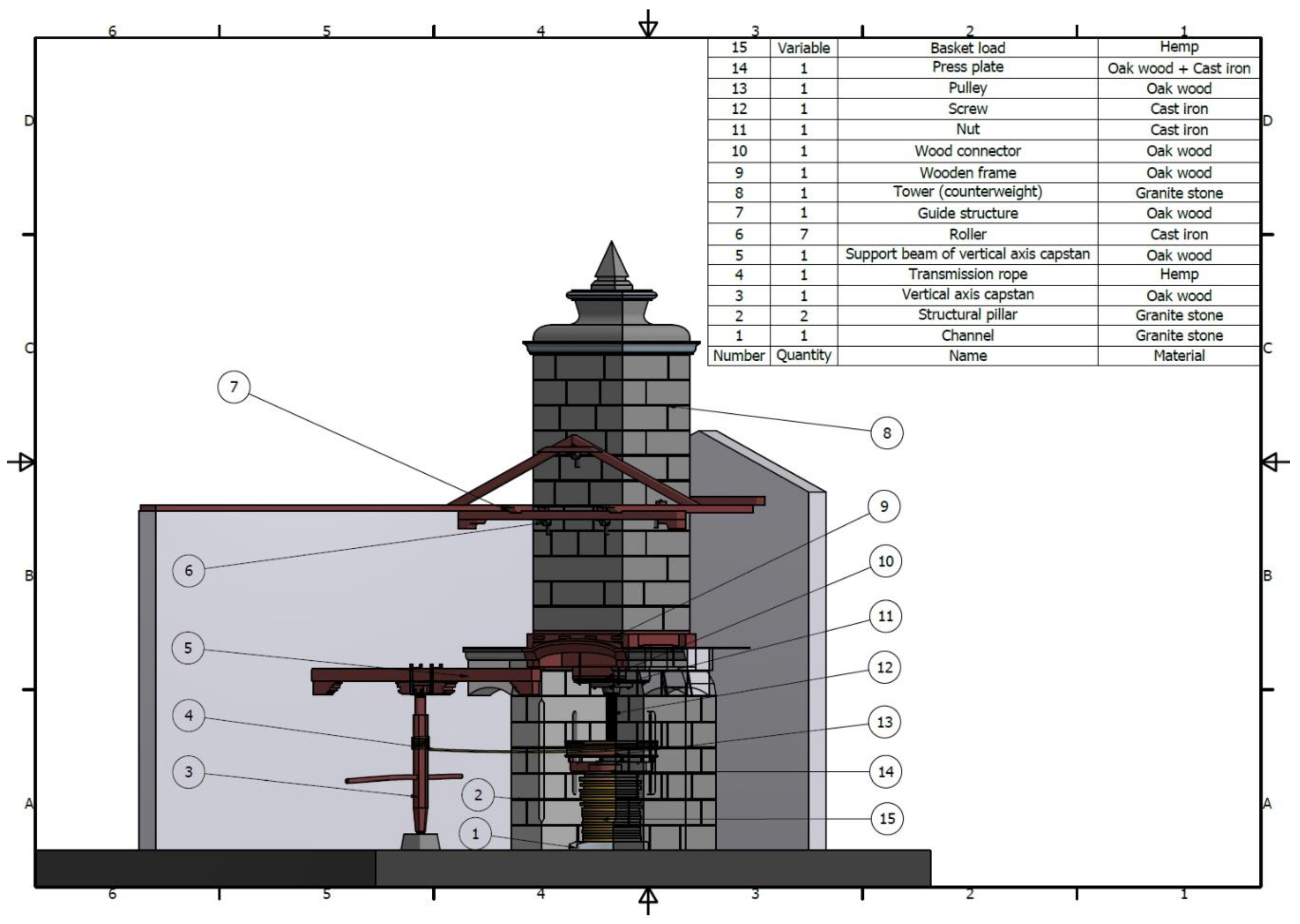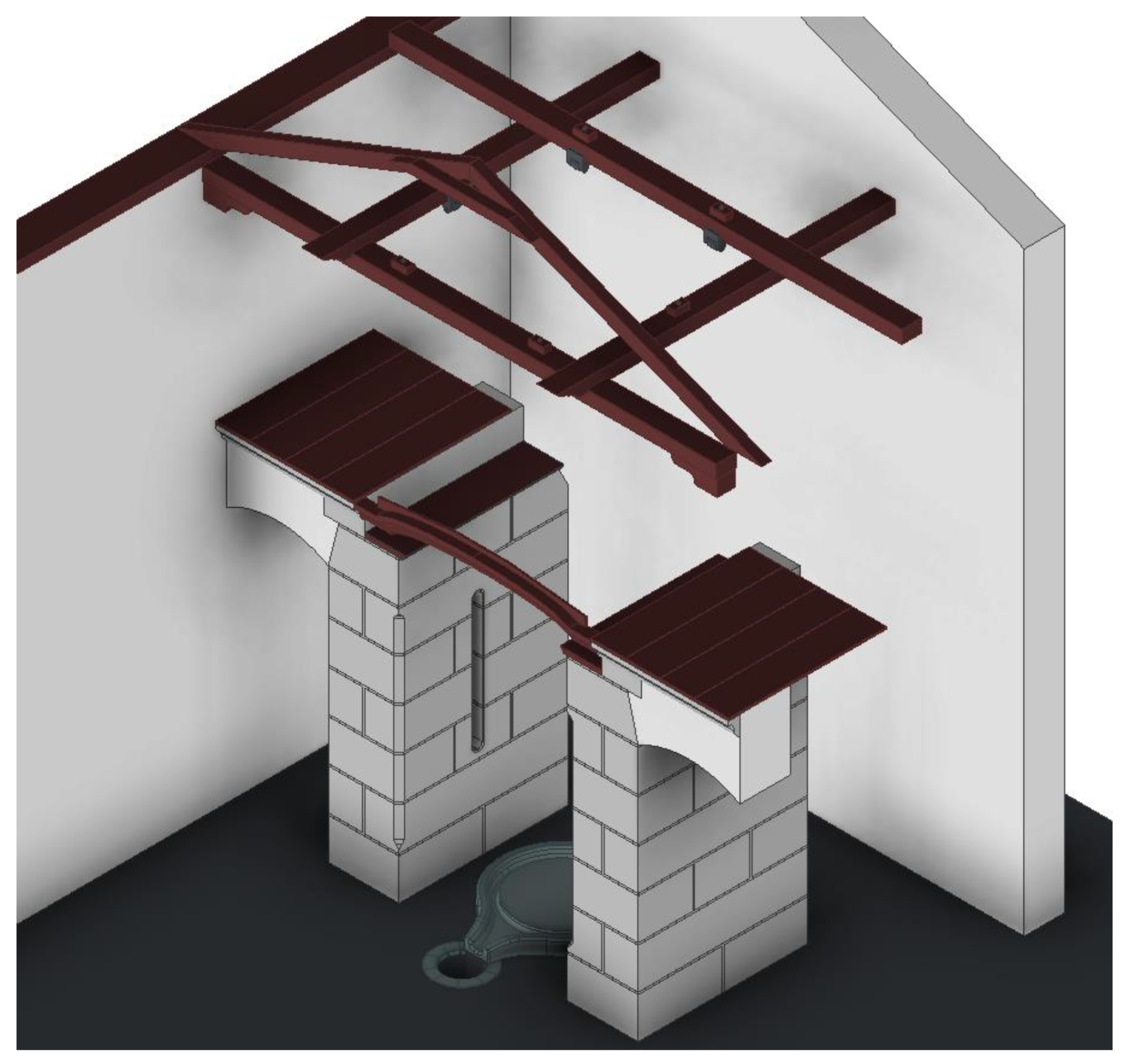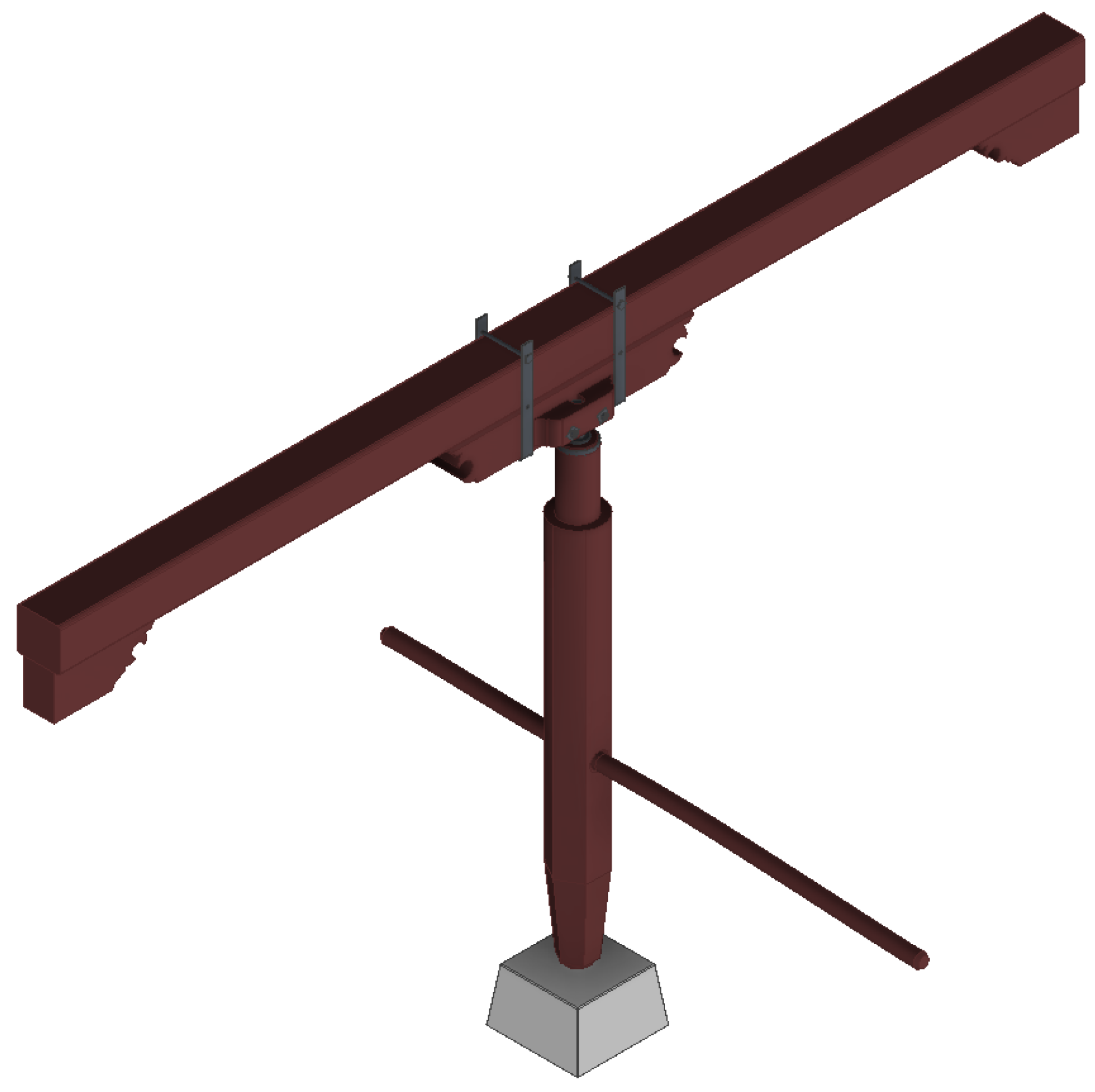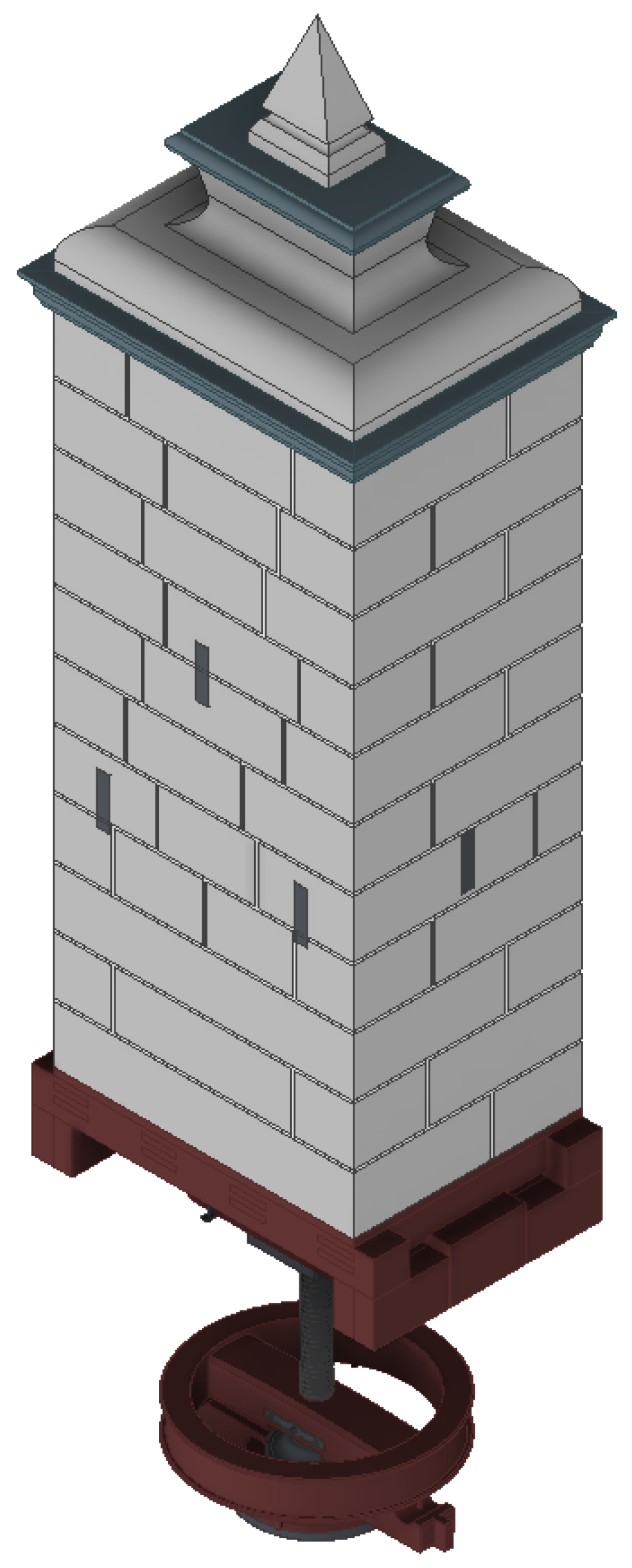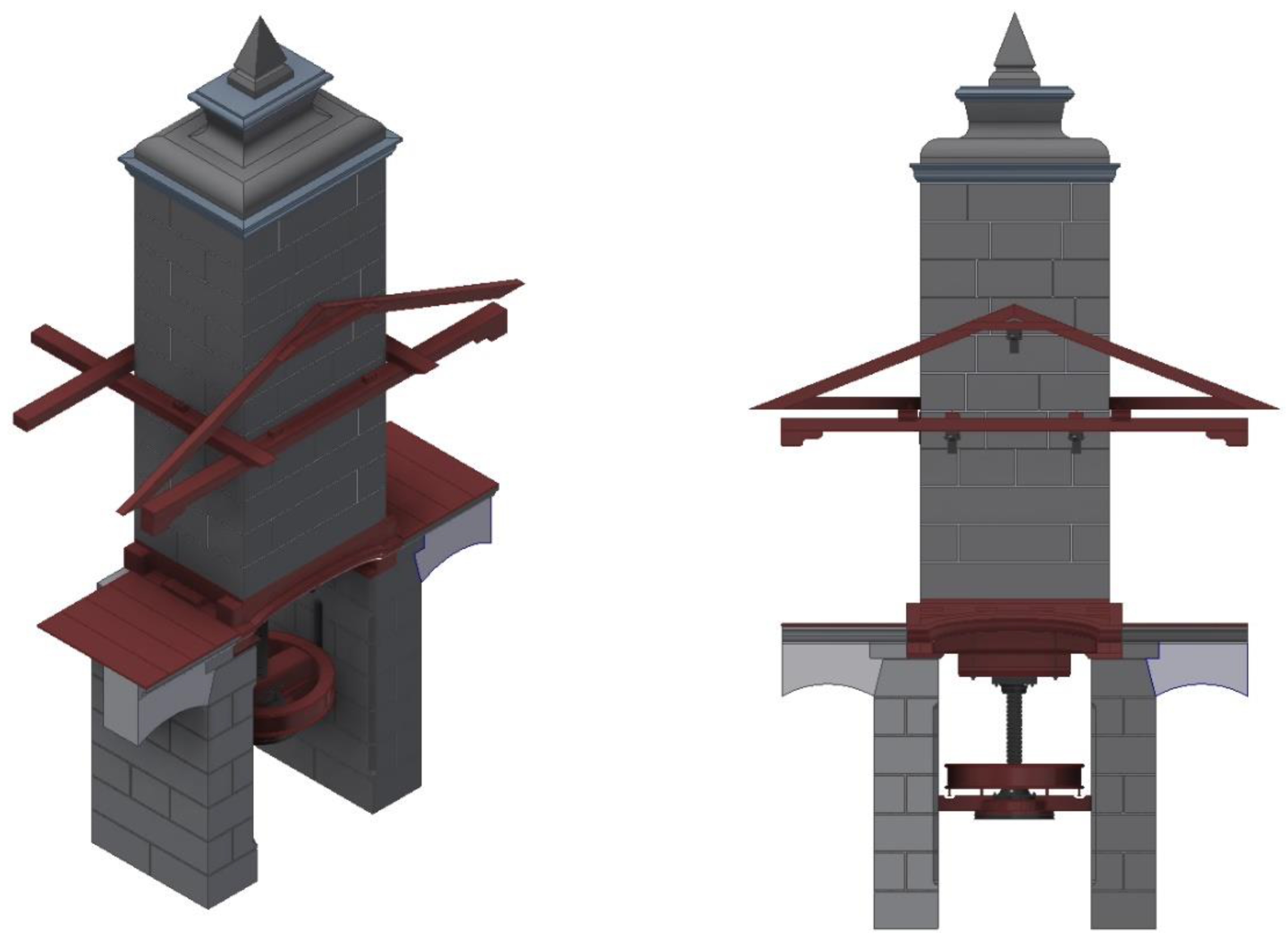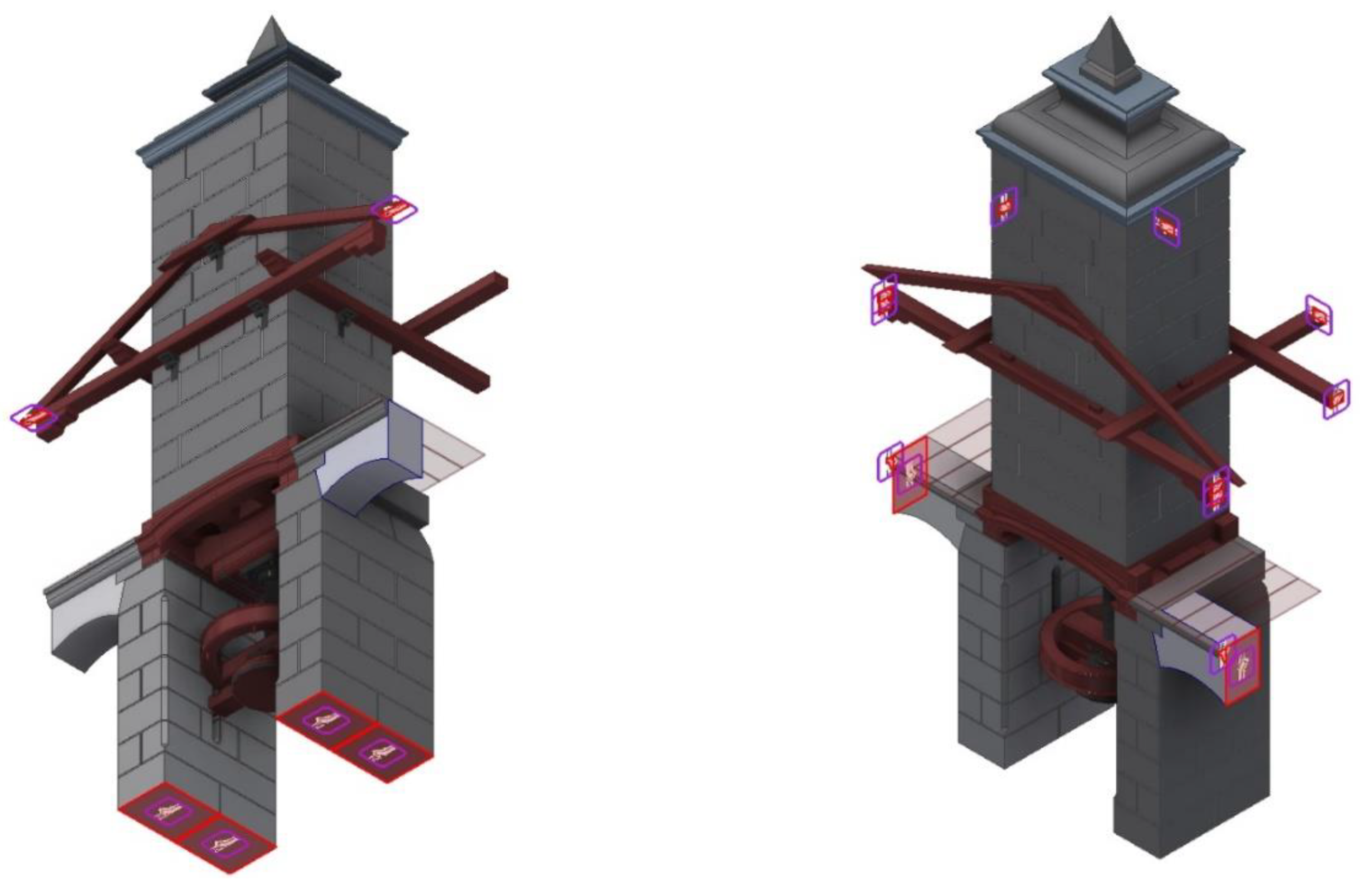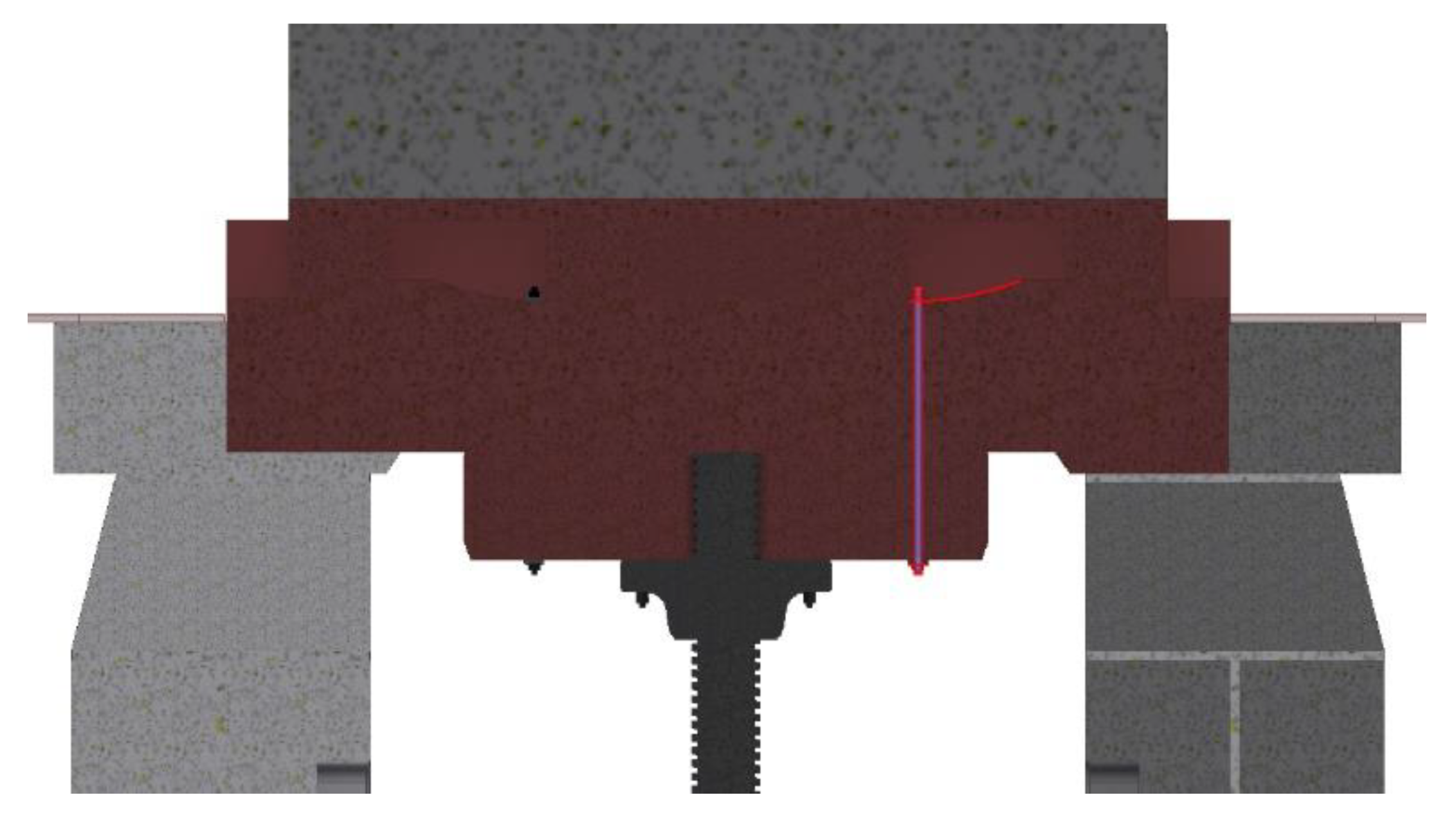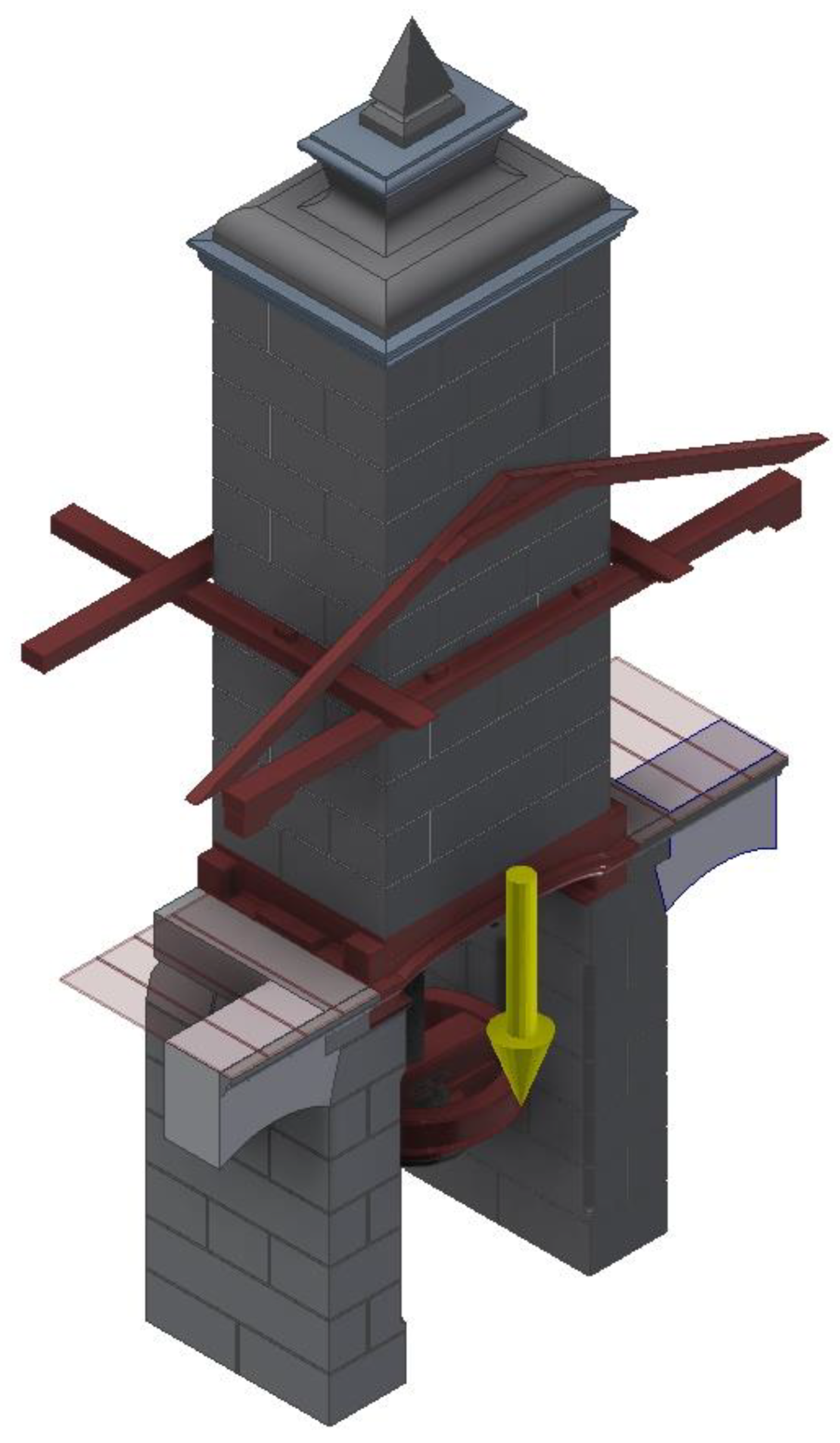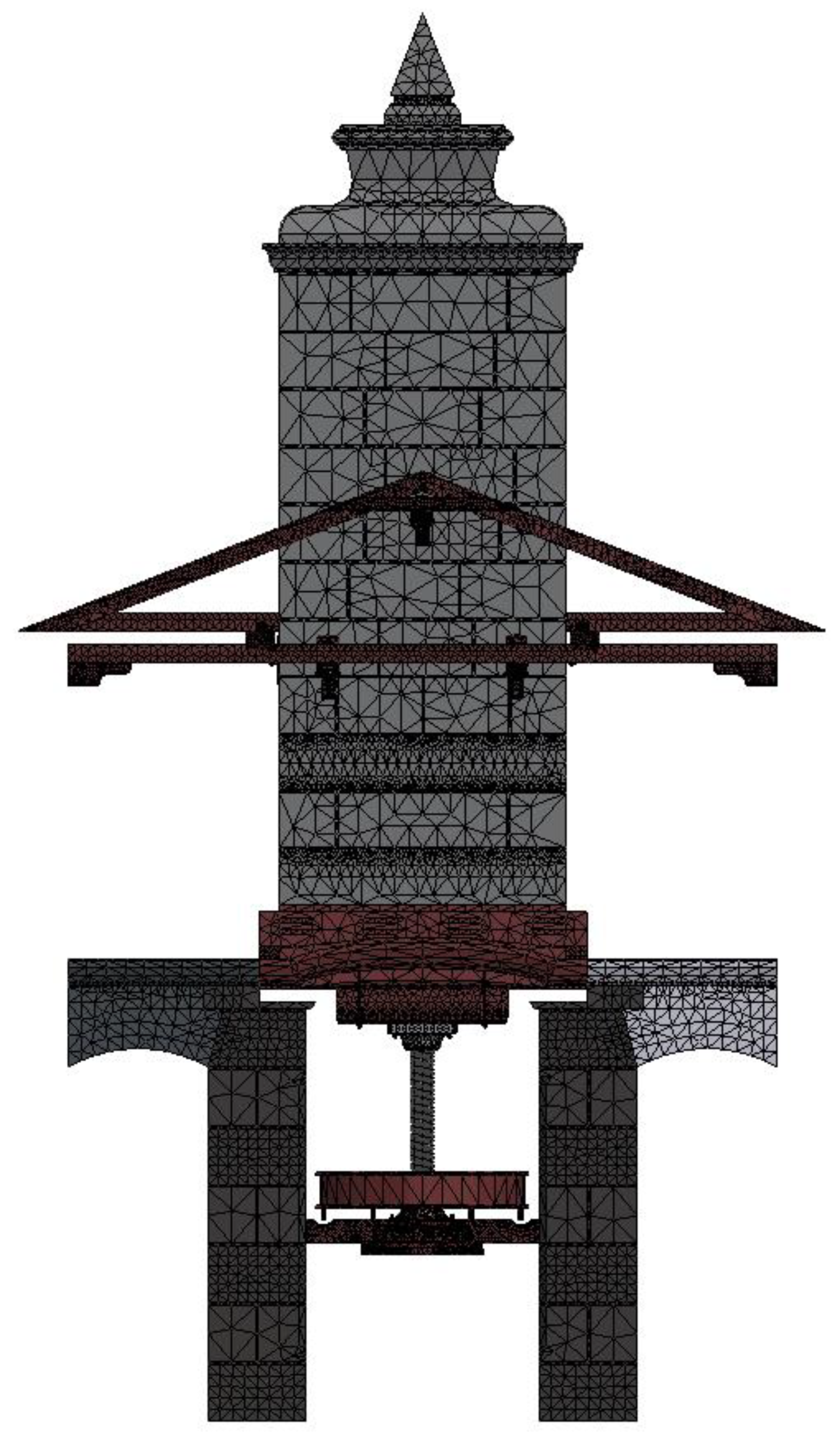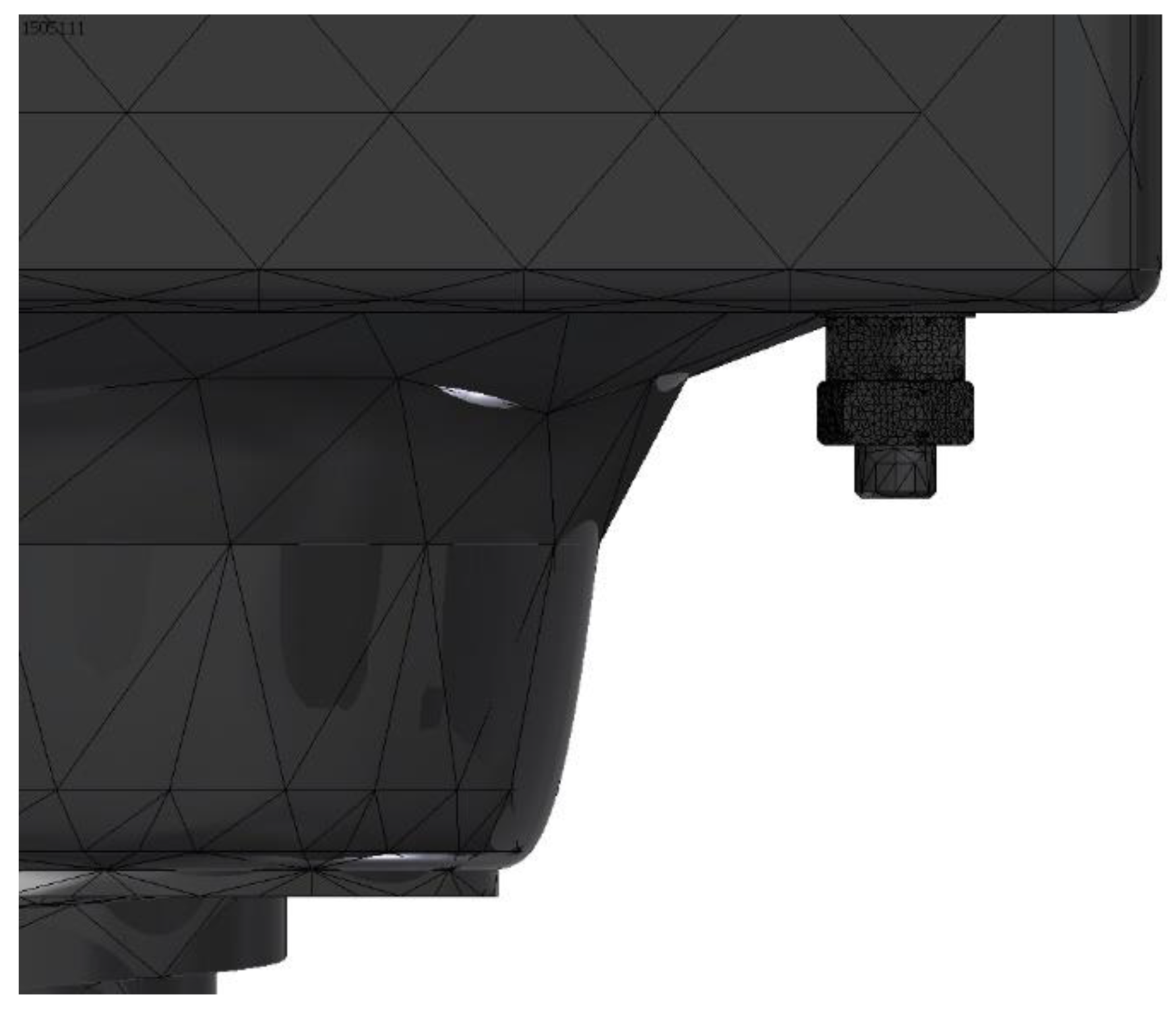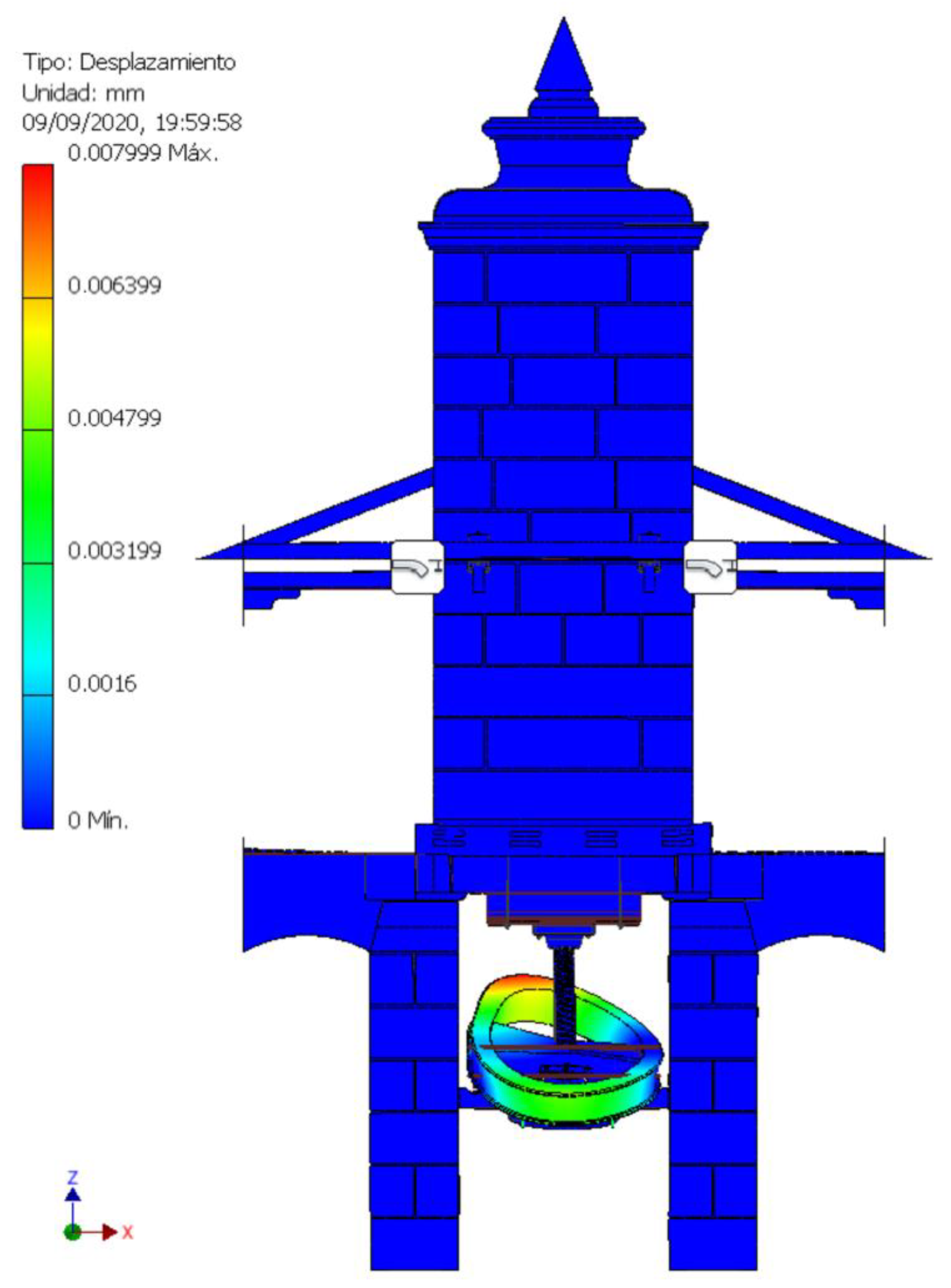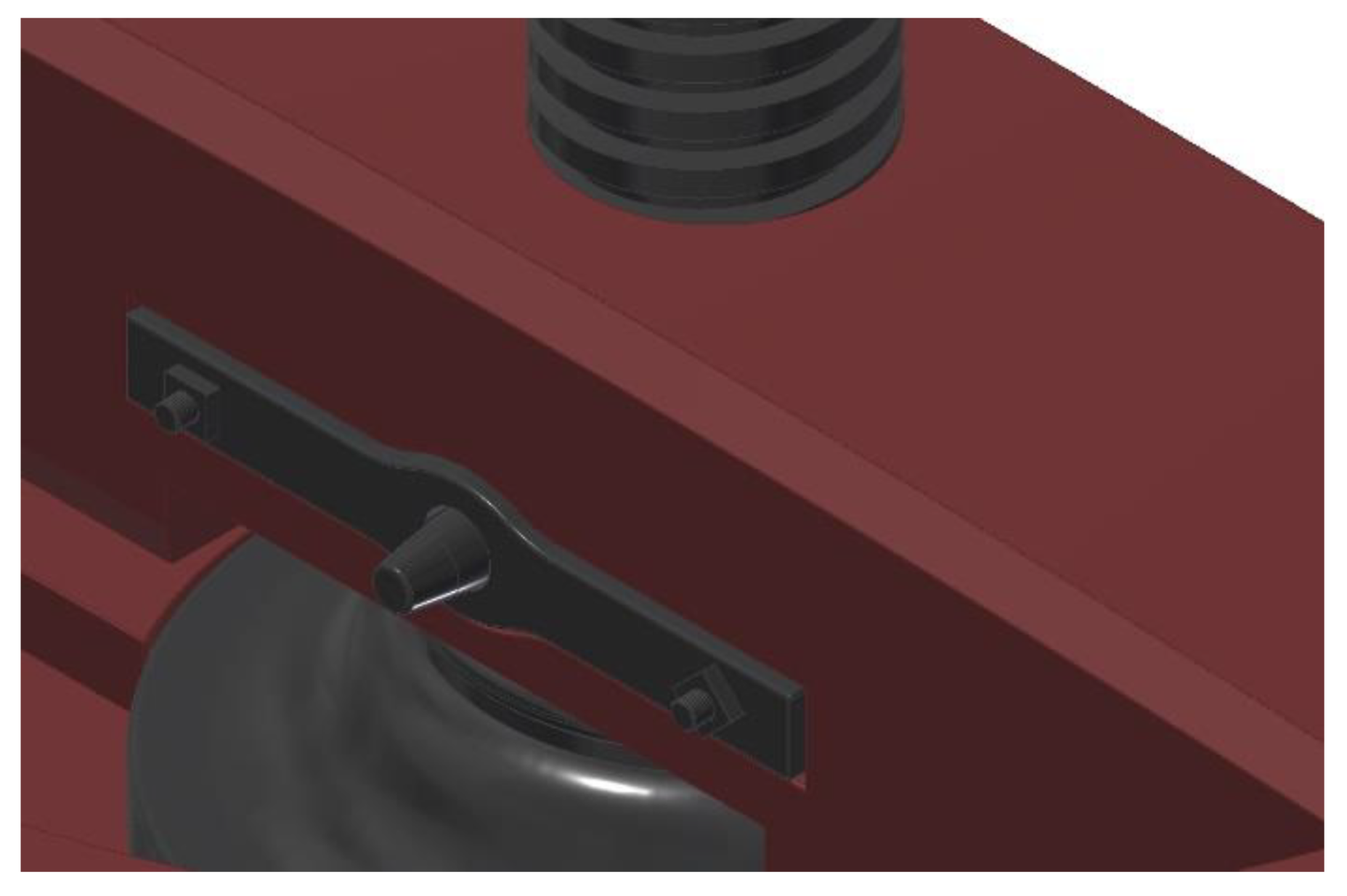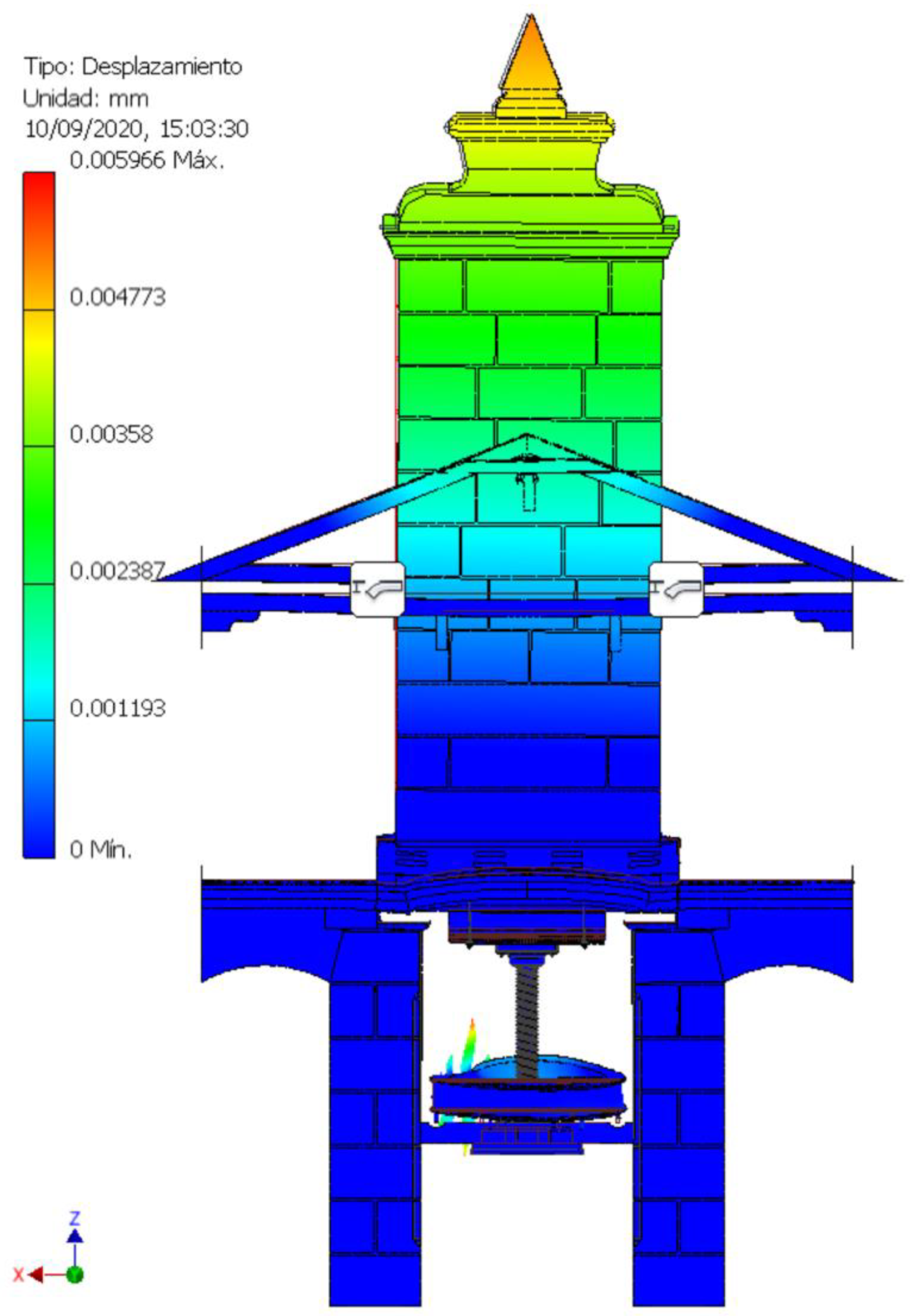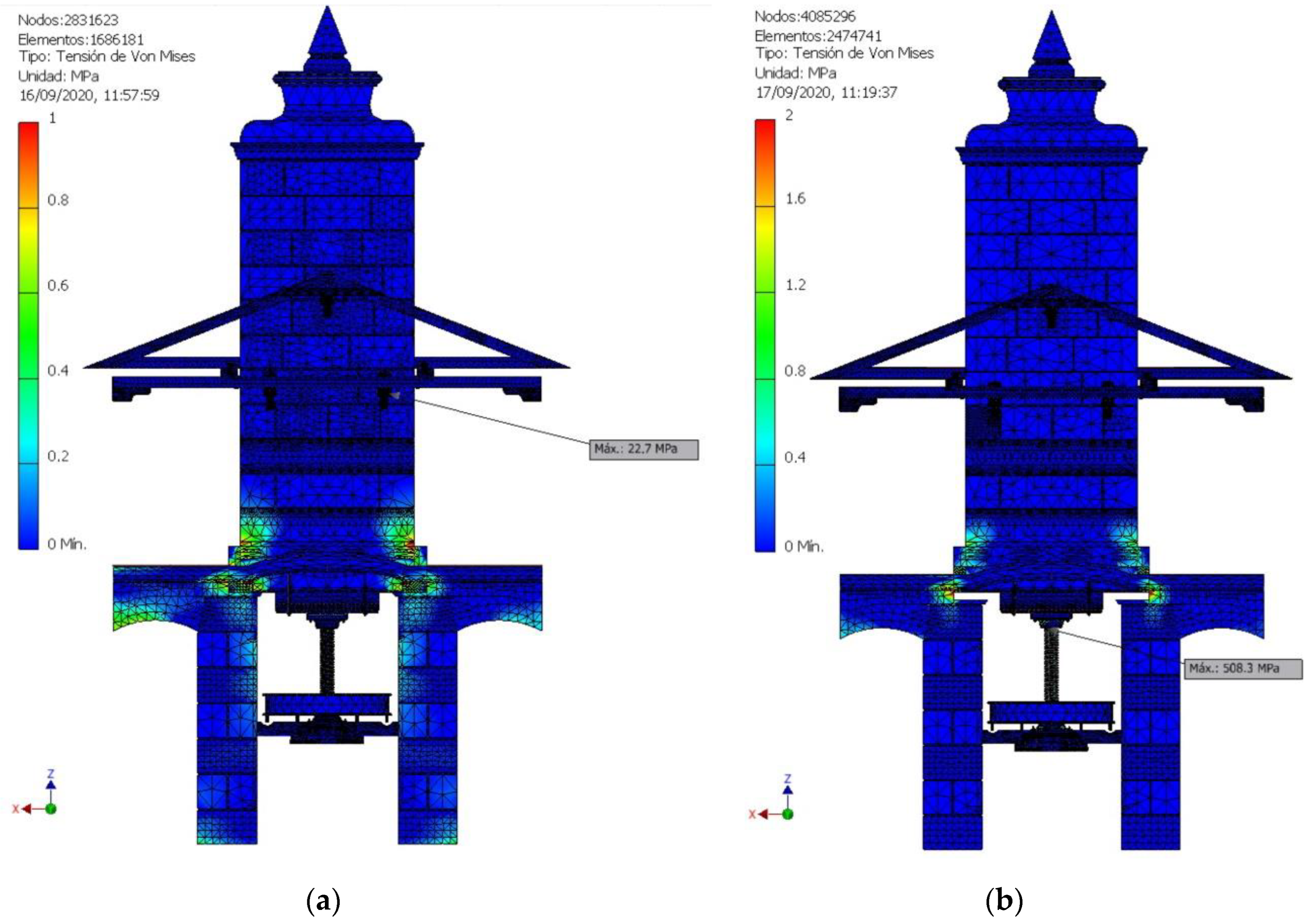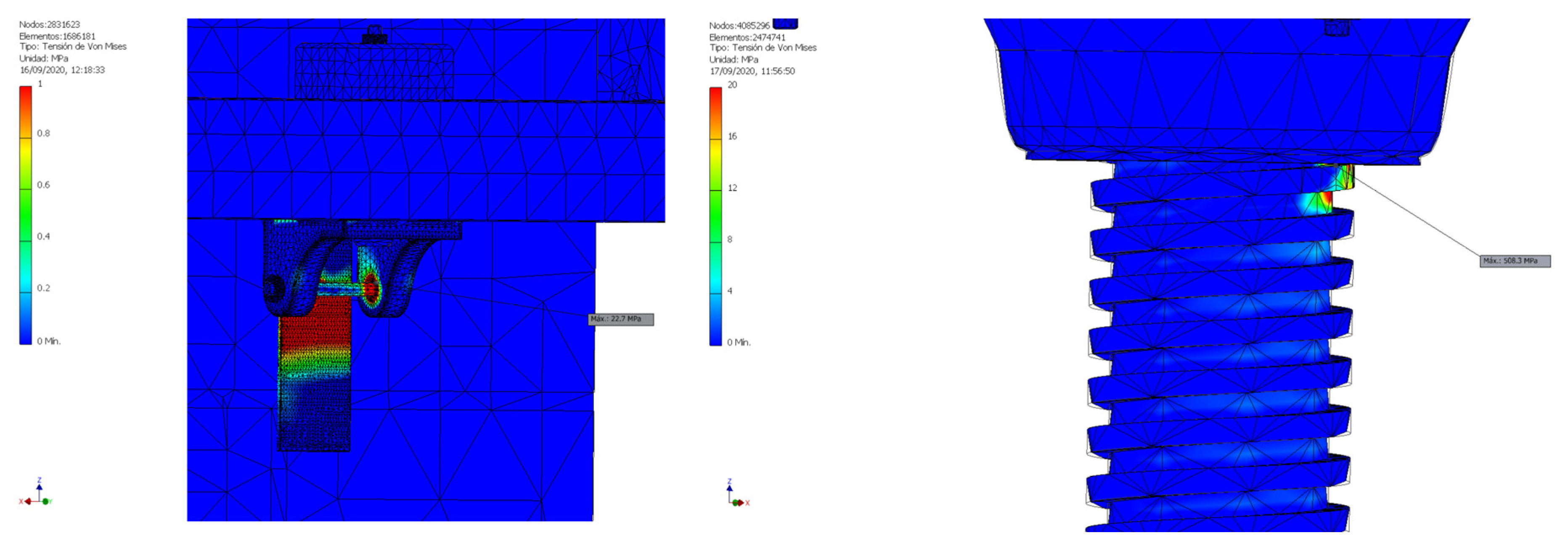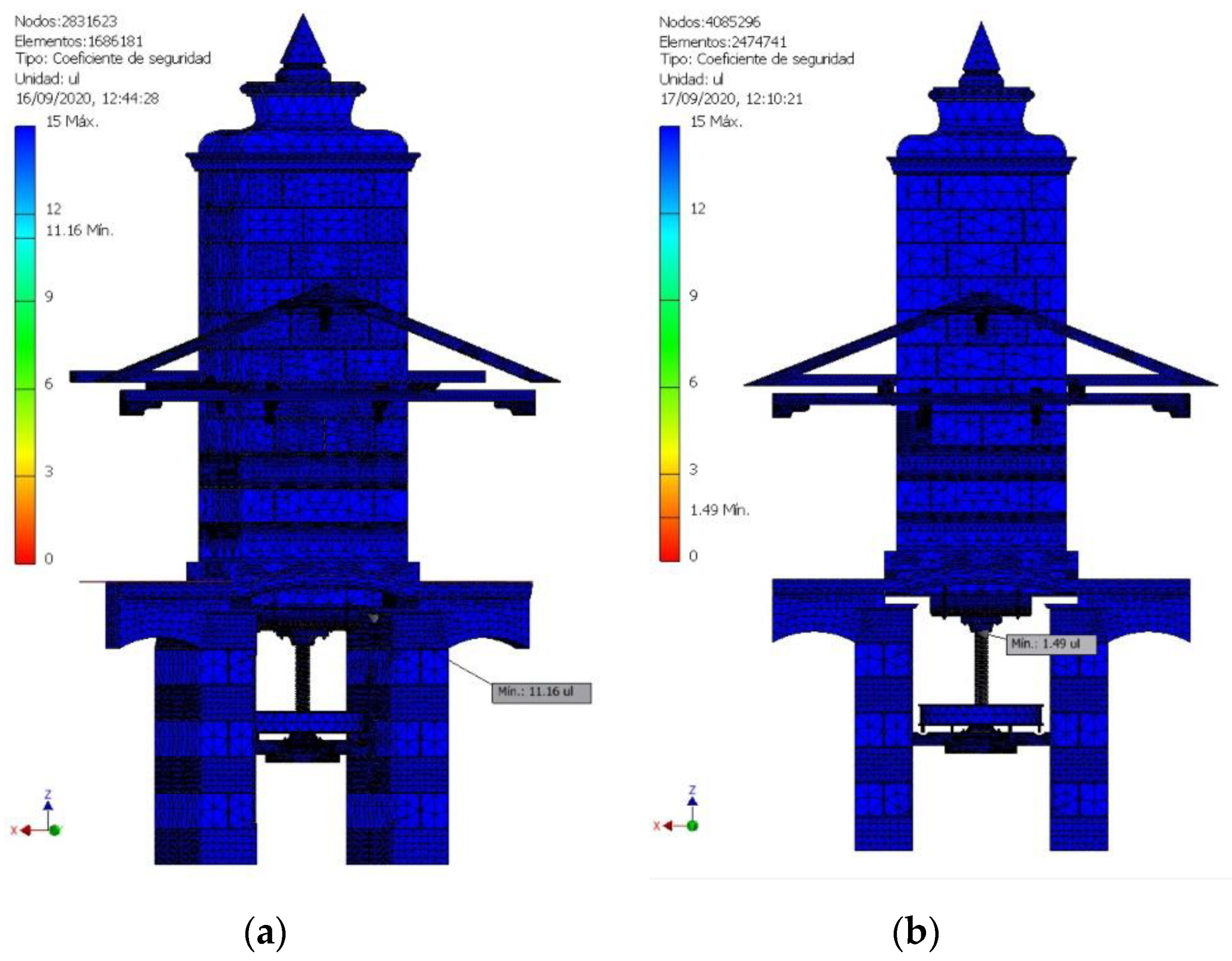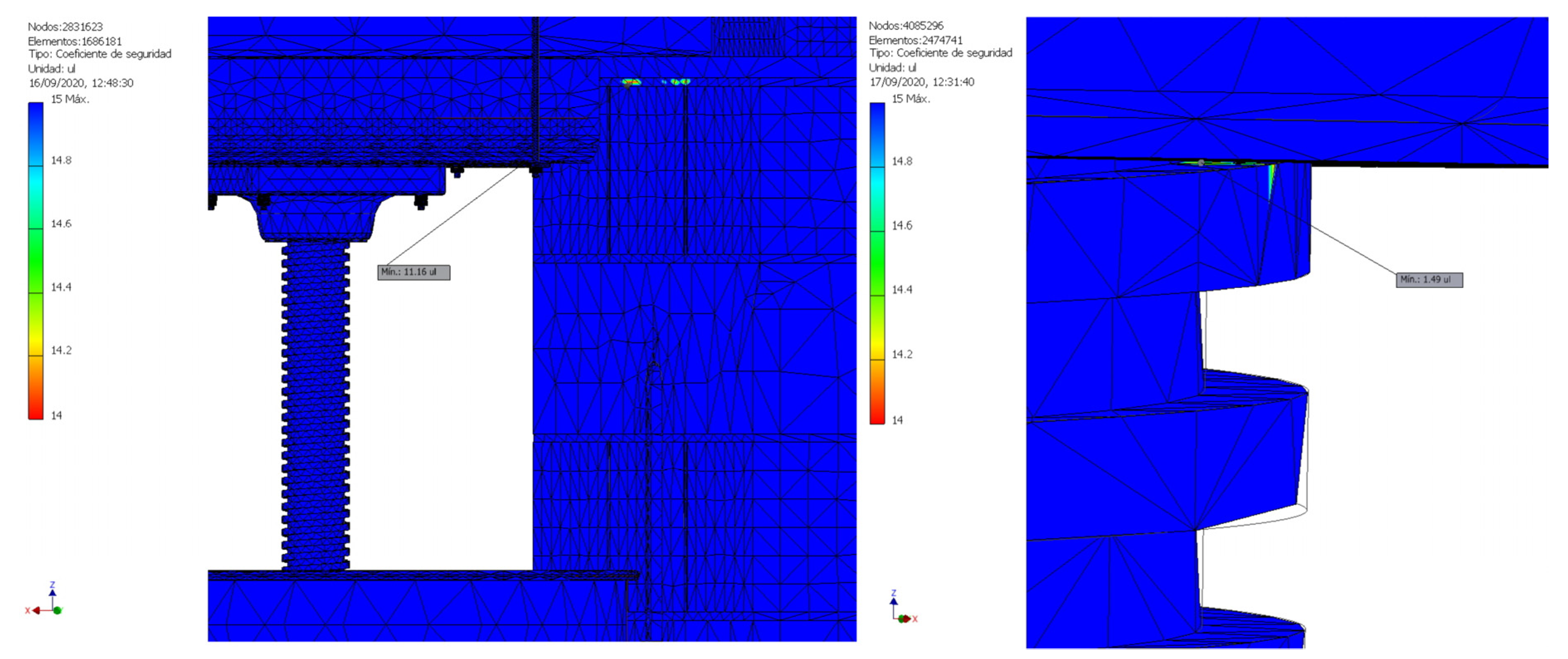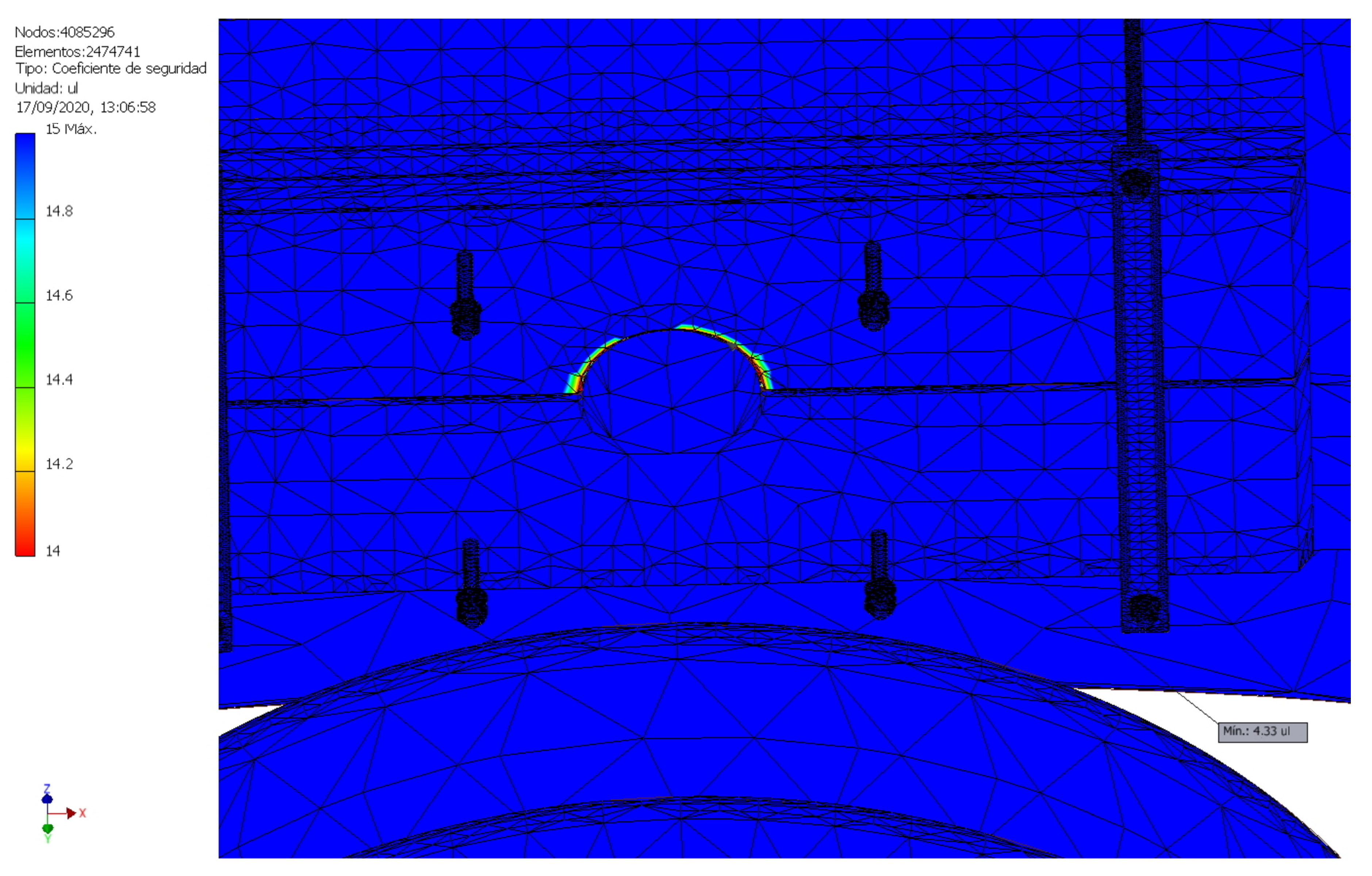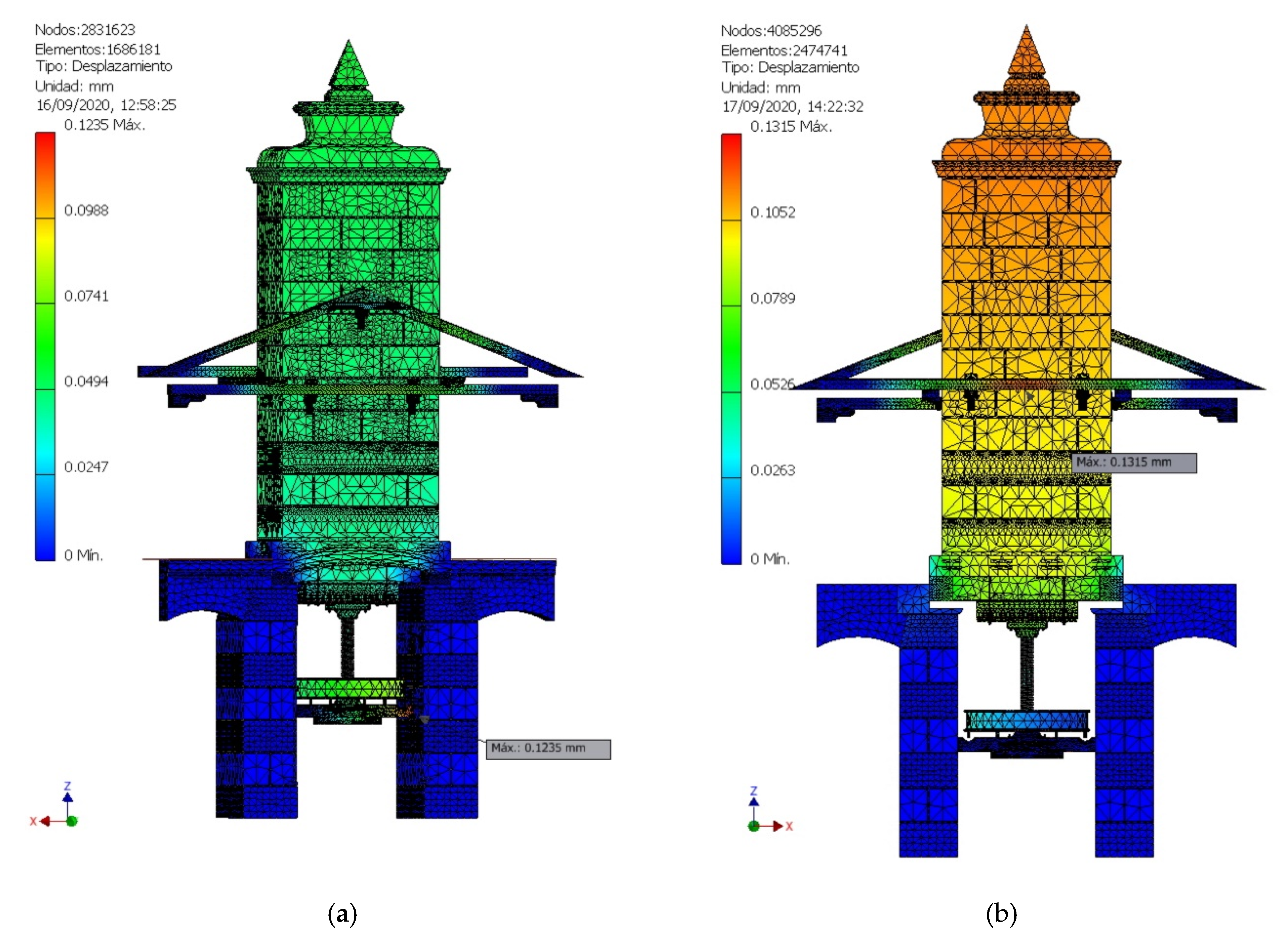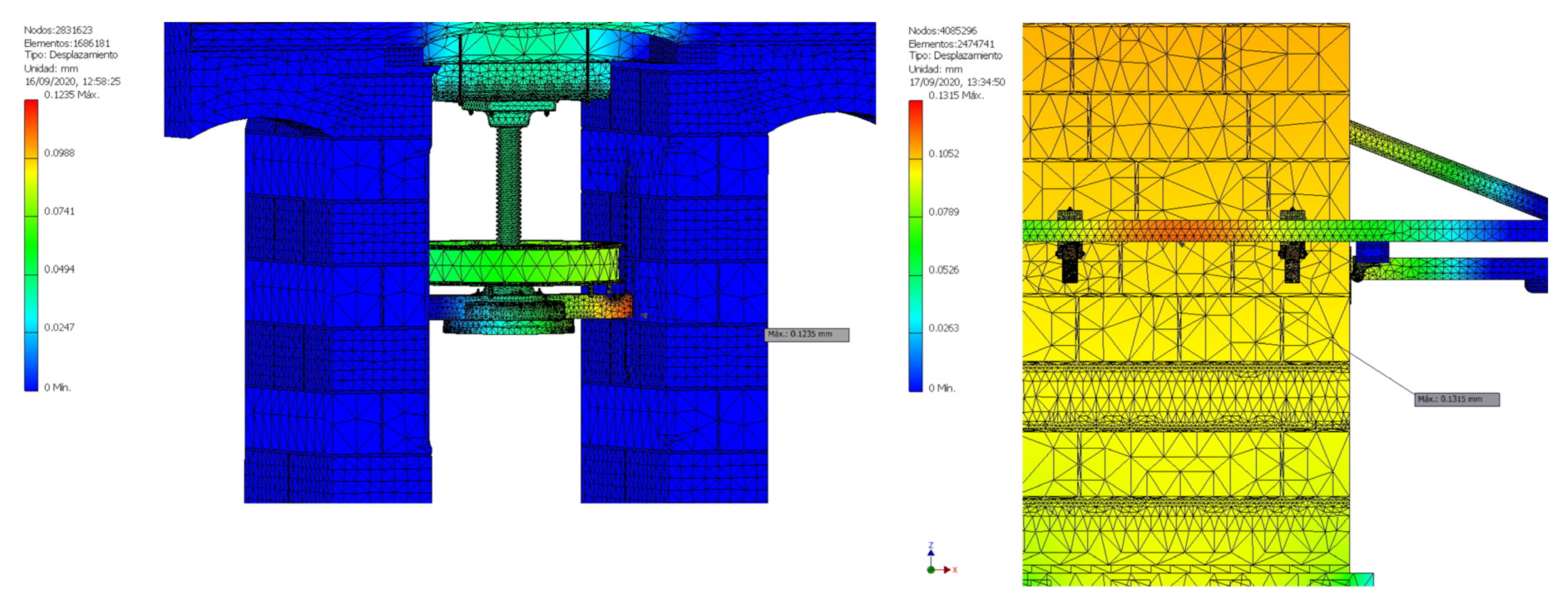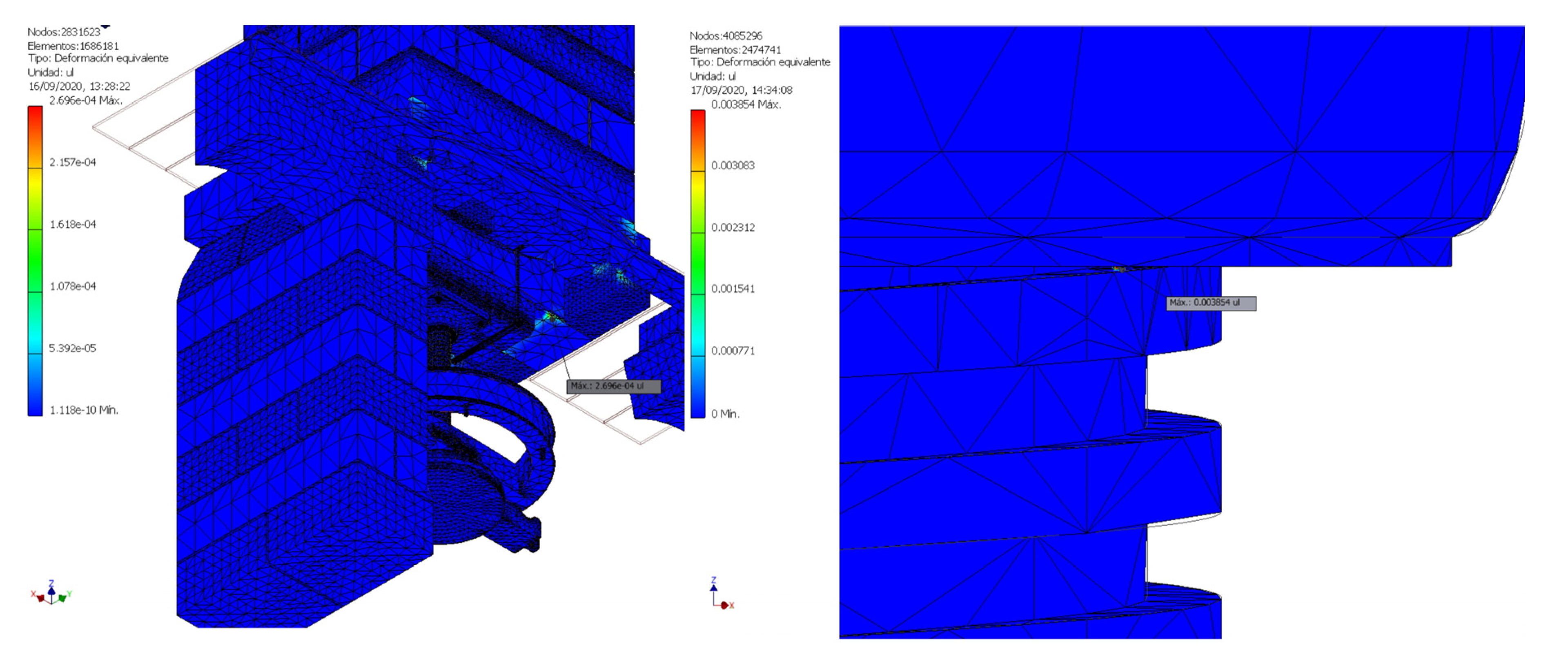Finally, it has been possible to perform the CAE simulation from the 3D CAD model using FEM to perform a static analysis of the tower press as a whole.
2.1. Operation of the Tower Press
The first step in carrying out a satisfactory analysis is to understand how the tower press worked, and, for this, the assembly plan that includes all its elements will be used (
Figure 2).
The operating principle of the tower press is common to all direct action gravity pressing systems, that is, it involves dropping a large tower formed by stones onto the basket load (15).
The tower (8) is made of granite and is free to move in the vertical direction thanks to a system of guides and rollers (6) housed in two trusses adjacent to the tower that form a guide structure (7) that guarantees the vertical movement of the tower. The lower part of the tower consists of a wooden frame (9) that has a double function: when there is no pressing, that is, in a resting situation (
Figure 3a), this frame rests the weight of the tower on two pillars (2), and when there is pressing (
Figure 3b), its weight acts on the basket load (15). These are the two limit positions that are studied in the present research.
To understand how the mechanism works, the starting point is the resting position in which the tower rests on the pillars. In principle, under the element that will directly press the basket load (press plate) called ‘marrano’ (14), there is a free height to form the load. As this basket load is formed and reaches a certain height, the operator operates the vertical axis capstan called ‘palopedro’ (3). This element acts as a manual winch with a vertical axis, supported by a support beam (5) which allows it to rotate. Thus, by rotating the capstan the transmission rope (4) is wound. This makes the pulley (13) rotate, which is attached by means of a large bolt to a cast screw called ‘husillo’ (12). As the screw is turned, it is unscrewed from the nut (11) and begins to descend. At the lower end of the screw is the press plate, which goes down jointly with the screw until at a certain moment it comes into contact with the basket load and the rotation stops.
The ingenuity of the system is that, at that moment, the operators continue turning the capstan, causing the screw to continue moving and the nut to continue unscrewing, but since the press plate can no longer descend, it is the tower that begins to ascend. Specifically, the wooden frame (9) stops leaning on the two pillars and rises a few centimeters, enough so that the weight of the tower is entirely over the basket load, and in a short time, the oily must (olive oil and alpechín mixture) runs through the baskets until it reaches a channel that surrounds the basket load called ‘regaifa’ (1) that collects it. After this time, the tower rests on the pillars, having ‘exhausted’ the basket load and reduced its height, that is, having pressed it completely. Finally, if the pressing has been satisfactory, the operators manually turn the pulley so that the press plate rises and the pressed baskets can be removed.
Moreover, the elements of the tower press can be organized from the point of view of their functionality. A first set of elements would be those destined to serve as a support to the tower, such as the structural elements that are fixed, facilitating its vertical movement (
Figure 4). A second set would be the elements of the vertical axis capstan, whose purpose is to operate as a vertical axis winch that facilitates the movement of the press plate and, consequently, of the tower itself (
Figure 5). The final set of elements would make up the mobile part of the press and control the process of pressing the basket load that contains the ground olive paste (
Figure 6).
2.2. Computer-Aided Engineering (CAE)
From the 3D CAD model, a static analysis has been carried out using the finite-element method (FEM) thanks to Autodesk Inventor Professional software.
2.2.1. Pre-Processing
This is the first step to being able to carry out an effective static analysis of the model, and it consists of simplifying and establishing the positions in which this analysis will be carried out. This is so because there are elements of the model that are not structurally involved in the analysis or also because their presence can be replaced by a movement restriction or a load. However, the simplification process must always respect the results of the analysis, that is, if the model is not simplified, the result should be the same.
From the computational point of view, the greater the number of elements, the greater the geometric mesh and the mathematical model on which to apply FEM, and this mainly translates into a greater demand on the computer processor and, therefore, into a longer calculation time. Therefore, obtaining a simplified model that yields the same results as a non-simplified model enables analysis with lower computational requirements. On the other hand, it is also necessary to determine in which limit positions the model works, as the elements that make up the tower press assembly are subject to different stresses in each position.
Following the order explained previously, the element to be studied has been simplified by eliminating a series of elements of the structural part that will be replaced by movement restrictions at some points, thus generating what are called supports.
The base, the building enclosure and the channel that collects the oily must are not part of the body of the model and are easily replaceable, as will be seen in the boundary conditions section. On the other hand, the entire vertical axis capstan system has no influence on the main structure, since it is responsible for raising or lowering the screw and allowing different positions in the press, but its elimination does not influence the static analysis of the tower press as a whole. Finally, the moving part of the press is adopted without any simplification.
Figure 7 shows the simplified model. On this model, the two limit positions shown in
Figure 3a,b will be studied: Position 1, in which the tower is supported by the pillars, and Position 2, in which the tower rests on the basket load.
2.2.2. Assignment of Materials
During the 3D modeling process of the tower press, the software allowed us to assign a material to each element of the assembly, although the stress analysis module of Autodesk Inventor Professional also allows users to assign a material to each element again or to modify the physical properties of the assigned material. This is an important task since if any of the elements does not have a material assigned, the software does not allow stress analysis.
On the other hand, the software requires the behavior of the material to be defined, that is, if it is isotropic and has the same properties in all directions, or if it is orthotropic, in which case its properties depend on the direction in which they are measured. In the latter case, it is proposed to replace the orthotropic material with an isotropic one elaborated from an average behavior obtained from its three main directions.
Two isotropic and one orthotropic material have been involved in the present research. The isotropic materials have been cast iron (with which all metal parts were made) and polished granite (for stone materials). The characteristics of these have been obtained from the Autodesk Inventor Professional material library with their defined properties. Thus, the physical properties of cast iron are: Young’s modulus 120,500 MPa, Poisson’s ratio 0.30, density 7150 kg/m3, and an elastic limit of 758 MPa. For its part, polished granite has a Young’s modulus of 55,000 MPa, a Poisson’s ratio of 0.25, a density of 2700 kg/m3, and an elastic limit of 39 MPa.
For elements made of oak wood, considering it as an orthotropic material, the direction of the grain has been defined as the most resistant to the direction of the longest element. Thus, oak wood has been assigned with three different values of Poisson’s ratio and Young’s modulus depending on the direction, but with a constant density value of 760 kg/m3 and an elastic limit of 41 MPa in the direction parallel to the grain.
2.2.3. Boundary Conditions
The third step prior to static analysis is to establish the boundary conditions. As previously stated, the two limit positions to be studied are closely related to the defined supports of the model.
By simplifying the model, some elements of the structure have disappeared and, therefore, it is necessary to correctly define the supports so that the study of the simplified model does not yield different results from the real one.
The supports that are defined are the classic supports used in the calculation of structures: fixed, articulated and mobile supports. However, Autodesk Inventor Professional does not define supports directly, but allows for the restriction of degrees of freedom of movement to specific surfaces, that is, the supports must be defined based on restrictions to the affected surfaces.
Figure 8 shows the surfaces that have a total restriction of movements, which would correspond to a fixed support. These are specifically the pillars of the press in their insertion in the base, the support of the arches and the beams on the walls of the building where the tower press is housed. Furthermore, these boundary conditions are common to the two limit positions to be analyzed, whether the tower is supported by the pillars (Position 1) or the basket load (Position 2).
Figure 9 shows a movement restriction that will only be produced in the case in which the tower rests on the basket load (Position 2). In this case, the lower surface of the press plate rests on the basket load and its vertical movement is impeded. It is, therefore, a mobile support in which the vertical movement of the surface is prevented. Once this support is defined, the model can dispense with the presence of basket load made of a material such as hemp, which is difficult to simulate and has variable physical properties.
Thus, once the supports have been defined, the software allows the contacts of the different elements that are part of the final assembly to be automatically generated. If the press is well modeled and its geometry is not excessively complicated, the automatic contacts coincide with the actual contacts between elements. In the case of the present research, a difficulty appeared that has been solved by manually defining the contact between elements. These are the metal clamps that join the wooden connector and the wooden frame, made up of two metal plates and the two large screws that join them. The problem is that the contact between the wooden frame and the plate is not flat, and the software is unable to establish it (
Figure 10). Therefore, by selecting the surfaces that should be related and accepting the contact, the software corrected this problem. Apart from this difficulty, the software defined the rest of the contacts perfectly.
2.2.4. Forces Applied
The next step is to define the forces that act on the press. At first, it might seem that there are two fundamental forces that intervene on the structure: gravitational action and that from the action of the vertical axis capstan on the pulley, but this is not the case.
The gravitational action, represented in
Figure 11, is the one that affects the set of elements of the model, and as will be explained below, it is the only force that acts in the pressing of the basket load.
To define this force, the acceleration of gravity with a value of 9.81 m/s2 in the negative direction of the z axis has been taken.
The mass of the moving part of the press (tower with a height of 6.93 m), which is what is going to exert pressure on the basket load, is 45,988 kg, which means a force of 451,142 N.
Furthermore, the surface of the press plate that comes into contact with the surface of the baskets is 0.578 m2, so the pressure that will support the charge of baskets is 780,522 Pa, which is more than enough to extract the oily must from the previously-ground olives.
However, the force derived from the action of the vertical axis capstan has no reason to appear in the static analysis of the model, since the function of this element is only to rotate the pulley that is integrally attached to the screw, screwing it or unscrewing it on the nut that joins the connector to the wooden frame.
The pulley rotates freely in Position 1, that is, when there is no lower opposition from the basket load. As the structure is supported by the pillars, the screw can adopt any position without any resistance from the structure. Therefore, in this position, it is unnecessary to define the force.
In Position 2, when the tower is supported by the basket load, the vertical axis capstan must overcome the resistance of the tower to be lifted, which is caused by gravitational action; furthermore, if the capstan is stopped from rotating, the tower does not return to its original position resting on the pillars. Thus, it can be said that Position 2 can be characterized without the intervention of forces on the pulley. This is, therefore, the situation that has been chosen to perform the static analysis, thus avoiding the intervention of more actions than necessary.
2.2.5. Meshing
Meshing is the last action to take before running the stress analysis. Meshing consists of the geometric discretization of the model, generating a volumetric network of tetrahedra that simulate its geometry. Each of the vertices of the volume is a node that is related to its neighboring nodes, and the values it presents in relation to those neighboring nodes can be written as a system of linear equations that can be solved by iterative methods. The greater the number of nodes, the greater the computational requirements necessary to solve all the equations.
Generally, the software that performs the FEA uses tetrahedral elements tetra 10 (4 physical points and 10 nodes). More specialized software allows for the use of hexahedral volumes, such as hexa 8, hexa 20 or hexa 27, to perform meshing in dynamic analysis or in static analysis of elements with very complex geometries. The mesh formed by hexahedra, compared to the one formed by the tetrahedral, generates the same volumes with fewer elements, but also with less geometric precision. The choice of hexagonal meshes reduces computational requirements and saves time and maybe from mathematical point of view the result would be better (total number of nodes is reduced and there are fewer differential equations), but the mesh does not conform to the real geometry. In a linear analysis such as the current one, there is no problem in using volumes of tetra 10 because the total number of elements to be analyzed is not excessive and the geometry will be better characterized.
In other types of simulations, for example, in lighting or thermal analysis, the use of bar or shell elements is more frequent. It is evident that this type of element, of a lower order, has much fewer elements (and calculation time) but the problem is, to adapt 2D elements to 3D models, this simplification, which is not always possible, requires time and must be well justified in order to analyze the real model.
It is important to find a balance. The results obtained using higher order meshes, the tetrahedral ones, generally differ little from those obtained by other 3D methods, and the 2D methods are difficult to implement in the present case; therefore, the use of a tetrahedral mesh is the one that has been imposed in this analysis. Furthermore, the mechanism that is being studied, at the time it was built (the study of the calculation of structures had not been extended), is an oversized structure.
On the other hand, the default tetrahedral mesh proposed by Autodesk Inventor Professional has problems when the geometry is complex. To avoid this problem, the software allows for reworking the mesh manually (mesh refinement), determining the maximum distance between nodes in some regions or in regions where stresses are concentrated, since if the mesh fits the geometry better the results are more reliable.
In the present research, a tetrahedral mesh has been obtained from the default values offered by the software. The mean size of the mesh element is 0.1 times the size of the bounding square, its minimum size is 0.2 times that of the mean element, and the variability factor between contiguous elements is 1.5. Finally, the maximum angle of rotation between tetrahedral surfaces is 60°. With these parameters, the mesh result obtained is precise, adjusting correctly to the geometry (
Figure 12 and
Figure 13).
In Position 1 (tower supported on the pillars) a mesh with 1,505,111 elements and 2,535,879 nodes was obtained. However, in Position 2 (tower resting on the basket load), a larger mesh was obtained with 2,474,741 elements and 4,085,296 nodes, since when the tower is raised it presents a larger surface without contacts and more elements are needed to define its geometry.
In addition, the complex geometry of some elements and the concentration of stresses that they are going to undergo forces a modification to be made in their mesh size, refining it. The meshing generated automatically by the software, which takes a mesh size proportional to the measure of the element, has caused some elements with a more complex and smaller geometry, such as the nuts or washers, to present a more refined mesh (
Figure 14) compared to the rest of the elements, so it was not necessary to modify their size.
